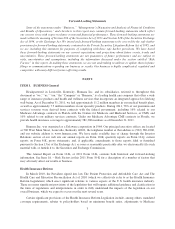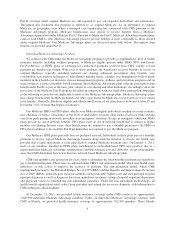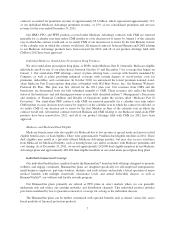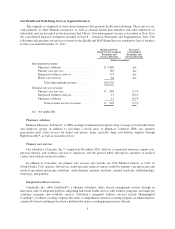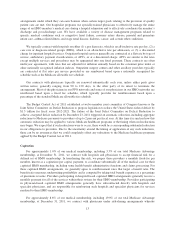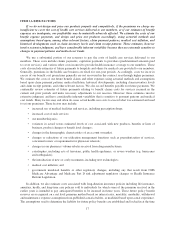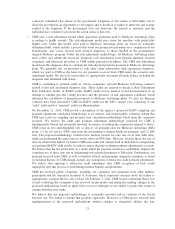Humana 2011 Annual Report Download - page 23
Download and view the complete annual report
Please find page 23 of the 2011 Humana annual report below. You can navigate through the pages in the report by either clicking on the pages listed below, or by using the keyword search tool below to find specific information within the annual report.arrangements under which they can earn bonuses when certain target goals relating to the provision of quality
patient care are met. Our hospitalist programs use specially-trained physicians to effectively manage the entire
range of an HMO member’s medical care during a hospital admission and to effectively coordinate the member’s
discharge and post-discharge care. We have available a variety of disease management programs related to
specific medical conditions such as congestive heart failure, coronary artery disease, prenatal and premature
infant care, asthma related illness, end stage renal disease, diabetes, cancer, and certain other conditions.
We typically contract with hospitals on either (1) a per diem rate, which is an all-inclusive rate per day, (2) a
case rate or diagnosis-related groups (DRG), which is an all-inclusive rate per admission, or (3) a discounted
charge for inpatient hospital services. Outpatient hospital services generally are contracted at a flat rate by type of
service, ambulatory payment classifications, or APCs, or at a discounted charge. APCs are similar to flat rates
except multiple services and procedures may be aggregated into one fixed payment. These contracts are often
multi-year agreements, with rates that are adjusted for inflation annually based on the consumer price index or
other nationally recognized inflation indexes. Outpatient surgery centers and other ancillary providers typically
are contracted at flat rates per service provided or are reimbursed based upon a nationally recognized fee
schedule such as the Medicare allowable fee schedule.
Our contracts with physicians typically are renewed automatically each year, unless either party gives
written notice, generally ranging from 90 to 120 days, to the other party of its intent to terminate the
arrangement. Most of the physicians in our PPO networks and some of our physicians in our HMO networks are
reimbursed based upon a fixed fee schedule, which typically provides for reimbursement based upon a
percentage of the standard Medicare allowable fee schedule.
The Budget Control Act of 2011 established a twelve-member joint committee of Congress known as the
Joint Select Committee on Deficit Reduction to propose legislation to reduce the United States federal deficit by
$1.5 trillion for fiscal years 2012-2021. The failure of the Joint Select Committee on Deficit Reduction to
achieve a targeted deficit reduction by December 23, 2011 triggered an automatic reduction, including aggregate
reductions to Medicare payments to providers of up to 2 percent per fiscal year. At this time it is unclear how this
automatic reduction may be applied to various Medicare healthcare programs or the timing when such reductions
may begin. We expect that if such reductions were to occur, there would be a corresponding substantial reduction
in our obligations to providers. Due to the uncertainty around the timing or application of any such reductions,
there can be no assurances that we could completely offset any reductions to the Medicare healthcare programs
applied by the Budget Control Act of 2011.
Capitation
For approximately 1.0% of our medical membership, including 3.3% of our total Medicare Advantage
membership, at December 31, 2011, we contract with hospitals and physicians to accept financial risk for a
defined set of HMO membership. In transferring this risk, we prepay these providers a monthly fixed-fee per
member, known as a capitation (per capita) payment, to coordinate substantially all of the medical care for their
capitated HMO membership, including some health benefit administrative functions and claims processing. For
these capitated HMO arrangements, we generally agree to reimbursement rates that target a benefit ratio. The
benefit ratio measures underwriting profitability and is computed by taking total benefit expenses as a percentage
of premiums revenue. Providers participating in hospital-based capitated HMO arrangements generally receive a
monthly payment for all of the services within their system for their HMO membership. Providers participating
in physician-based capitated HMO arrangements generally have subcontracted directly with hospitals and
specialist physicians, and are responsible for reimbursing such hospitals and specialist physicians for services
rendered to their HMO membership.
For approximately 8.6% of our medical membership, including 19.0% of our total Medicare Advantage
membership, at December 31, 2011, we contract with physicians under risk-sharing arrangements whereby
13


